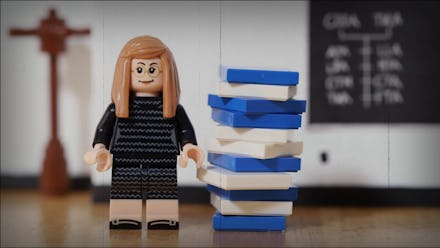The real story of Apollo 11's moon landing, told in Lego stop-motion animation

On July 20, 1969, astronauts Buzz Aldrin and Neil Armstrong landed Apollo 11 on the moon. It was one of the greatest technological and scientific achievements in American history — but Aldrin and Armstrong didn't do it alone. Many, many engineers contributed to making humankind's first moon landing possible, and 50 years later, the story of their collaborative efforts is being told via a Lego-animated, stop-motion film created for website Hack the Moon.
The video, which is just a minute long, follows Charles Stark "Doc" Draper and his team of engineers, who — between 1961 and 1969 — developed the revolutionary Apollo Guidance Computer. This computer, under the supervision of Margaret Hamilton, calculated the code needed to send Aldrin and Armstrong to the moon and return them home safely. In the film, Hamilton — who joined the Apollo project in 1965 — is shown working with her team to test out hundreds of simulations before finally finding the one that'd allow for the astronauts to make their journey without issue.
"My daughter Lauren would often come to work with me at nights and weekends because we were all so dedicated," Hamilton told Hack the Moon. "There wasn't a time when we weren't working. She liked to play astronaut because she saw me playing that way in certain simulations we would run."
Hamilton's team worked on the project for four years; as the video shows through its Lego animation, so much code was created that, when printed and stacked, the pile of papers was almost as tall as the engineer herself. Thanks to her team's hard work, the code was eventually completed in the beginning of 1969. Just a few months later, in July, Aldrin and Armstrong used those calculations to land on the moon.
Hack the Moon was created by Draper (formerly known as the MIT Instrumentation Lab) with the intent of providing the public with information about about America's 17 famed Apollo missions and the people who made them possible. While only 12 people walked on the moon during the programs, which ran from 1967 to 1972, NASA reports that the missions required the efforts of 400,000 people. To commemorate their work, Hack the Moon has archived personal accounts about the creation and development of the Apollo program from several trailblazing engineers, including Hamilton.
The site also features a look at the technology that has been used to build spacecrafts throughout the years, the various hardware and computer software used by the Apollo teams, and the potential technology that might be used in future space missions. And then there's the stop-motion video, a short but powerful look at the moon landing, the most well-known mission of them all.
As the short film shows, all of these journeys would not have been possible without the work of engineers like Draper and Hamilton, among so many others. Their contributions allowed for some of history's most exciting and technologically complicated missions to ever happen, and the video might just inspire budding engineers to follow their leads.
Watch the stop-motion video above, and learn more about Hack the Moon's project at wehackthemoon.com.